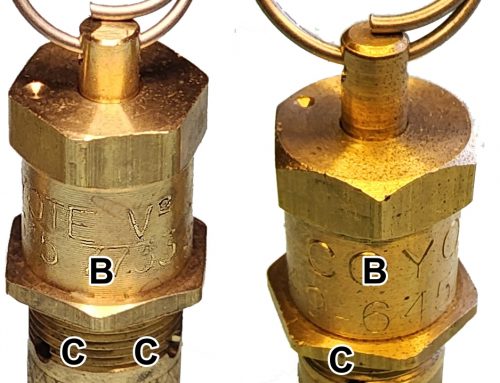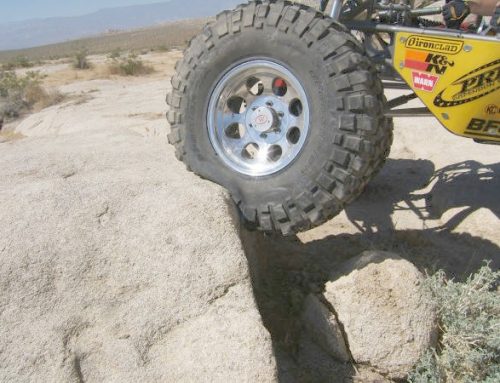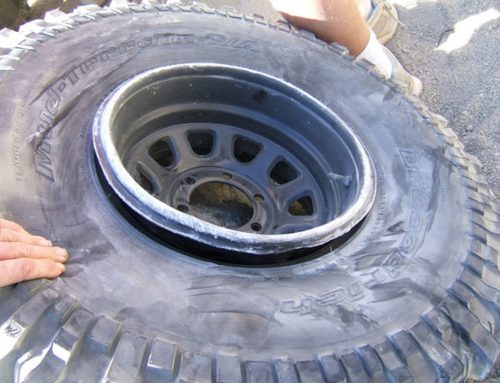TEMPERATURE AND TIRE PRESSURE
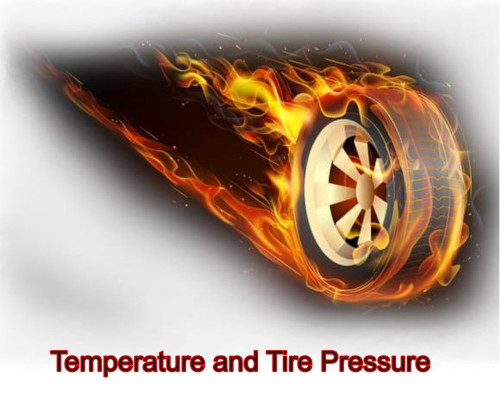 This article explores how temperature affects tire pressure. And understand that this has nothing to do with the kind of gauge you use or how much you paid for it. Any gauge will work for doing what I present. The only additional thing you’ll possibly need is an IR, point and shoot thermometer.
This article explores how temperature affects tire pressure. And understand that this has nothing to do with the kind of gauge you use or how much you paid for it. Any gauge will work for doing what I present. The only additional thing you’ll possibly need is an IR, point and shoot thermometer.
 With over 15 years of publishing the ECO4WD newsletter and several 4WD and offroad map books under my belt, I’ve learned this. Techie stuff is often TMI. However, I have to balance that with presenting what I think is important information. So, let’s first take a big picture look, solidify some common concepts and dispel some misconceptions. Then, we’ll move through all of the technical considerations and finish with a quick way to estimate temp, tire pressure changes.
With over 15 years of publishing the ECO4WD newsletter and several 4WD and offroad map books under my belt, I’ve learned this. Techie stuff is often TMI. However, I have to balance that with presenting what I think is important information. So, let’s first take a big picture look, solidify some common concepts and dispel some misconceptions. Then, we’ll move through all of the technical considerations and finish with a quick way to estimate temp, tire pressure changes.
THE BIG PICTURE: We’ll start by looking at how volume changes pressure. Hot tires may expand and not see as much pressure increase as expected. Do they? We’ll then sneak in some air density considerations. Next, we’ll look at how load weight affects tire pressure. Also, do various inflation gasses make a difference…does nitrogen expand differently than other gas? BTW, understand that air is included in my use of the word “gasses”. We’ll even take a look to see if temp affects our gauges. Boyle’s Law is the scientific way to answer this temp-tire pressure question perfectly, but there is a lot of techie funny business associated with what the 17th century scientist offers. I’ll also throw in: Is it harder or easier to hand pump up a weighted tire. Finally, I’ll provide an easy–to–use method for approximating what to expect when your tires change temperature.
VOLUME VERSUS PRESSURE: Cut a closed container volume in half and the pressure doubles. Double the container size and the pressure drops by half. Our high school physics taught us that. Techies call this an inverse, linear relationship. That’s like if you run the volume up, the pressure goes down. Both change at the same percentage only in opposite directions.
AIR DENSITY VERSUS VOLUME: Heat the air inside a balloon and it eventually floats. The heat makes the balloon grow and the volume change. That’s because the air (molecules) inside now occupies more space and produces more pressure. However, MOST importantly, the number of air molecules does not change unless you add or let air out! When heated, the increase is due to the hot little rascals furiously racing around and running into each other. Surround the balloon with the colder, slower molecules and behold, it floats. In 1783, Jean-François Pilâtre de Rozier and François Laurent d’Arlandes learned about this ( from Wikipedia.org). But do tires change size due to either pressure or temperature?
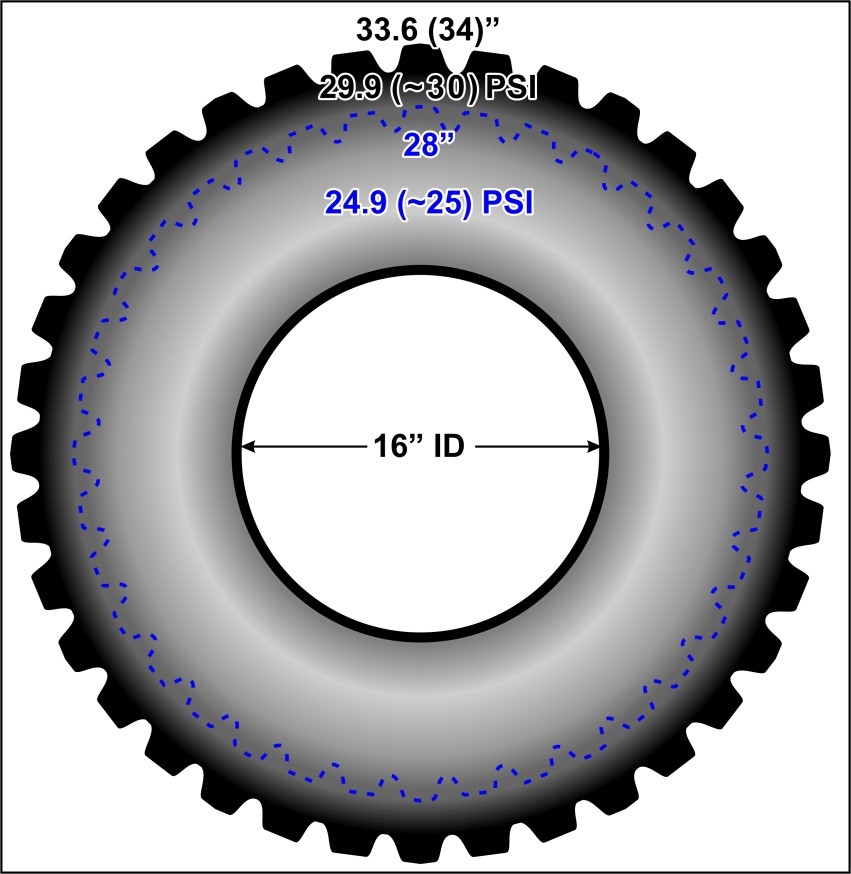 TIRE SIZE (VOLUME) CHANGE VERSUS PRESSURE: This boils down to just taking a practical look at it. Remember the halving the volume doubles the pressure thing above? Let your imagination and this image bring tire size change with pressure into perspective.
TIRE SIZE (VOLUME) CHANGE VERSUS PRESSURE: This boils down to just taking a practical look at it. Remember the halving the volume doubles the pressure thing above? Let your imagination and this image bring tire size change with pressure into perspective.
To simplify things for calculations, I assume that the tire is a simple donut shape (technically, a toroid or torus). Further, I neglect the tire’s elastic force. That’s its resistance to expansion. For reality, put your mind around the fact that tires are tightly bound together by very strong thick rubber, many layers of fiber cords and steel belts. This construction tries very hard to prevent tire size change.
The blue is a flexible tire on a 16” rim starting at 24.9 (25) PSI. It measures 28 inches and the 16 inch rim stays the same at both 25 and 30 PSI.
 Now inflate the tire to 29.9 (30) PSI (20% change). It has increased to 33.6 (34) inches (20%) in diameter (the black). That’s just a 5 PSI (20%) pressure increase, but the diameter changed from 28” to 33.6 inches or 5.6 inches (20%). Have you ever seen a tire change size by 20% with a 5 PSI increase? I haven’t.
Now inflate the tire to 29.9 (30) PSI (20% change). It has increased to 33.6 (34) inches (20%) in diameter (the black). That’s just a 5 PSI (20%) pressure increase, but the diameter changed from 28” to 33.6 inches or 5.6 inches (20%). Have you ever seen a tire change size by 20% with a 5 PSI increase? I haven’t.
Now let’s use what I call my $1,000 altitude box. We’ll measure the size change on a weaker, non-steel belted, hand truck tire with respect to altitude change.
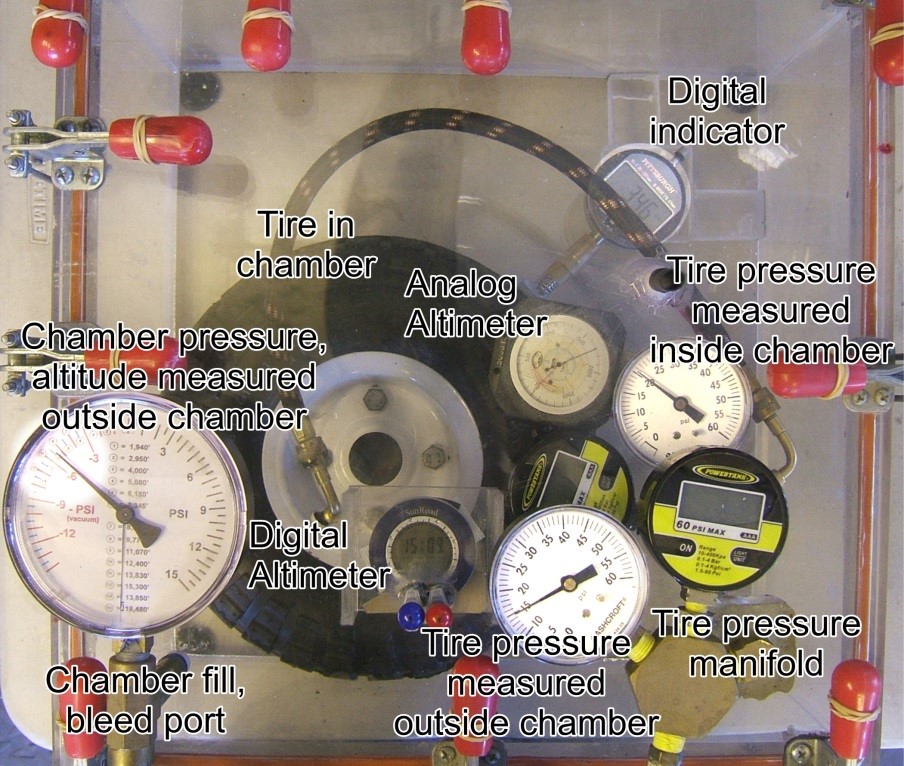 ALTITUDE SIMULATION BOX: This box can simulate elevations from 500 feet below to 30,000 feet above sea level. This configuration tests the effect of altitude change on a small tire. It has pressure gauges inside and out and a digital, tire size indicator (upper right). It also has digital and analog altimeters inside. The inflated (30 PSI), weaker, non-steel belted tire only showed about a ~0.010” change from sea level to well above the top of Everest. That’s only a 0.1% size change for a pressure change of 29% (14.7 PSI down to 4.37 PSI). This small change is only logical if you consider that the 30 PSI inside the tire easily resists the compressive force of 14.7 PSI outside the tire. The 4.37 PSI at 30K feet is even easier to resist. 30 PSI inside the tire wins in either case and the tire’s moderate construction prevented expansion and contraction.
ALTITUDE SIMULATION BOX: This box can simulate elevations from 500 feet below to 30,000 feet above sea level. This configuration tests the effect of altitude change on a small tire. It has pressure gauges inside and out and a digital, tire size indicator (upper right). It also has digital and analog altimeters inside. The inflated (30 PSI), weaker, non-steel belted tire only showed about a ~0.010” change from sea level to well above the top of Everest. That’s only a 0.1% size change for a pressure change of 29% (14.7 PSI down to 4.37 PSI). This small change is only logical if you consider that the 30 PSI inside the tire easily resists the compressive force of 14.7 PSI outside the tire. The 4.37 PSI at 30K feet is even easier to resist. 30 PSI inside the tire wins in either case and the tire’s moderate construction prevented expansion and contraction.
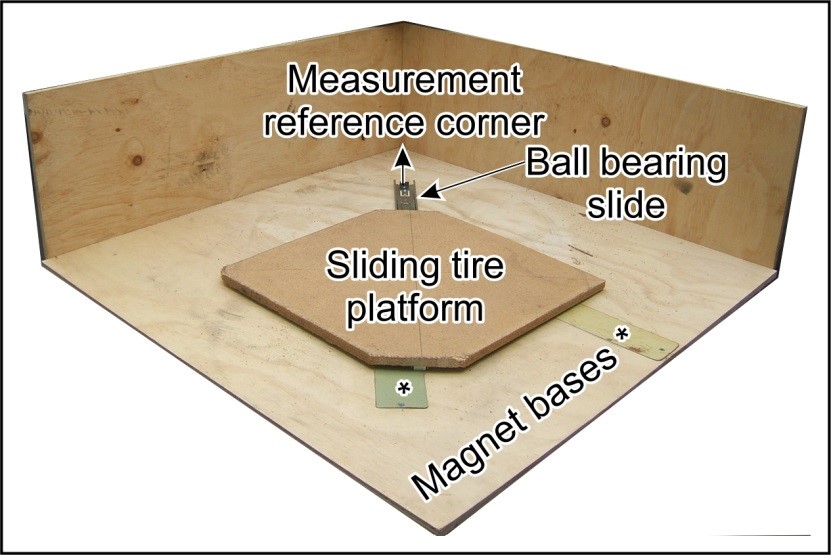 Just for the heck of it, check out what the box also shows. Inside and outside the box are identical, PSIG (more on the “G” later), analog tire pressure gauges (near the digital gauge). See the difference between them? This confirms how altitude (barometric pressure) affects all PSIG tire pressure gauges. Below and these two links from our Tech Tech present the details of what’s going on – Compensating Tire Pressure Readings for Elevation and How Tire Pressure Guages Work.
Just for the heck of it, check out what the box also shows. Inside and outside the box are identical, PSIG (more on the “G” later), analog tire pressure gauges (near the digital gauge). See the difference between them? This confirms how altitude (barometric pressure) affects all PSIG tire pressure gauges. Below and these two links from our Tech Tech present the details of what’s going on – Compensating Tire Pressure Readings for Elevation and How Tire Pressure Guages Work.
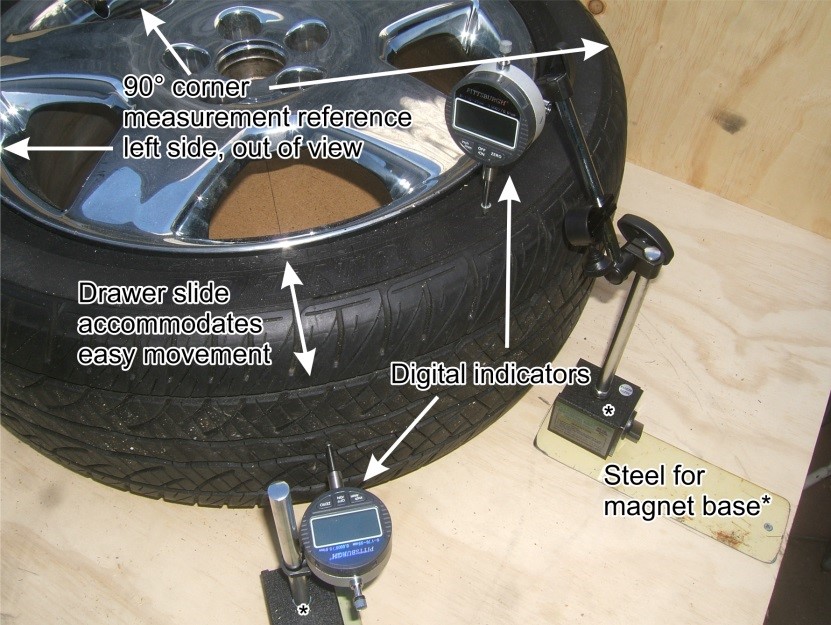 MEASURING TIRE SIZE (1): This exercise answers the question: Is tire size the same at 0 PSI and 30 PSI? I used this setup to check out what happens with real, steel belted, vehicle tires at sea level.
MEASURING TIRE SIZE (1): This exercise answers the question: Is tire size the same at 0 PSI and 30 PSI? I used this setup to check out what happens with real, steel belted, vehicle tires at sea level.
Tires of various sizes and types (40” offroad and 28” passenger car) were put on the ball bearing, slide mounted Tire Platform and shoved into the Reference Corner. The slide allowed the tires to easily move to accommodate the smallest of tire size changes. It avoided jerky tire movement from the reference corner.
The fixture was equipped with digital indicators on magnetic stands secured to steel plates to accurately measure the width and diameter size changes with pressure.
The valve core was removed, the tire was shoved into the corner and the indicators were zeroed. The wheel (that’s what I call a mounted tire on a rim) was then inflated from flat to where it first took full shape. This occurred at ~10 PSI. From 0 to 10 PSI, there was about 0.015” change in either direction. The tires were then progressively inflated and measured many times up to 80 PSI. There was no size change from first taking shape at 10 to 80 PSI. And scratch the thought that this was an unweighted tire. PSI is PSI regardless of how it is achieved, weighted or not.
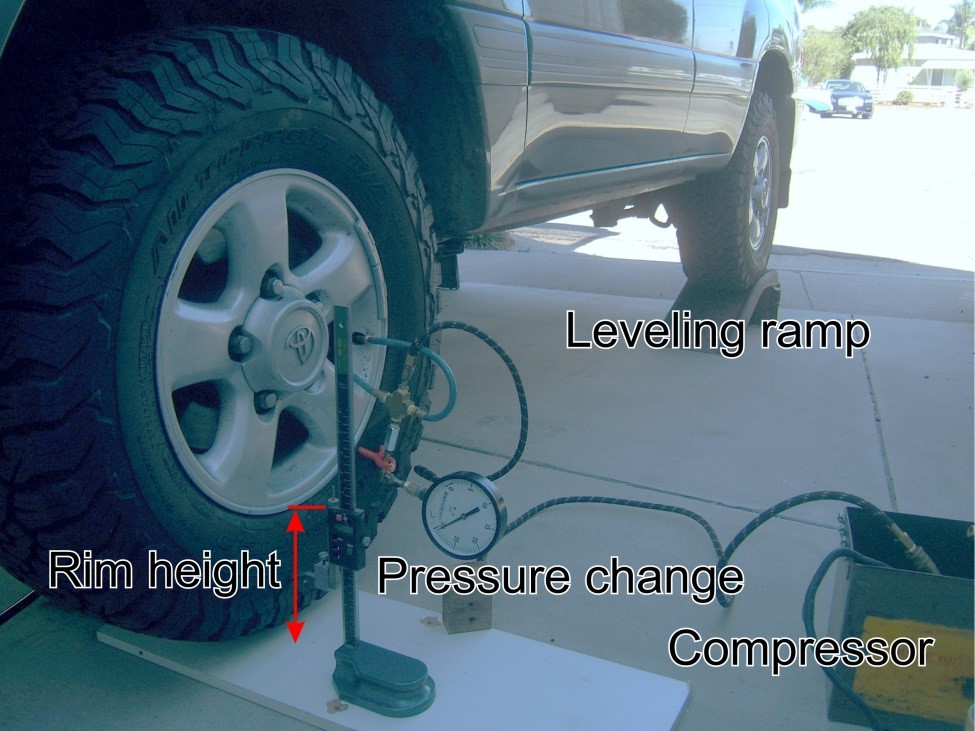 MEASURING TIRE SIZE (2): This relates to volume change with weight. Since the number of molecules inside a tire does not change, volume change would have a related pressure change. With this portable setup, I found that weight varies pressure less than 1% at 30 PSI and about 10% at 10 PSI.
MEASURING TIRE SIZE (2): This relates to volume change with weight. Since the number of molecules inside a tire does not change, volume change would have a related pressure change. With this portable setup, I found that weight varies pressure less than 1% at 30 PSI and about 10% at 10 PSI.
The process was to zero the height gage at the rim with the tire just off of the ground. I then inflated an elevated tire, let it down and then re-measured the pressure. I did this at 10 and 30 PSI.
To determine the “just touching” point, the inflated tire was let down onto a piece of paper. Then I’d slowly jack it up while gently pulling on the paper. At the point where I could slightly move the paper, I concluded that the tire was fully unweighted. I immediately stopped jacking. Next, I would zero the height gauge. Finally, I’d gently release the jack and again check the pressure and height. I did this for 30 and 10 PSI. 30 PSI showed virtually no pressure change and at 10 PSI, the pressure increased to about 11 PSI or 10%. Since this test was performed down near the coast at about sea level, would the same be true up at 8,000’ in the San Bernardino National Forest?
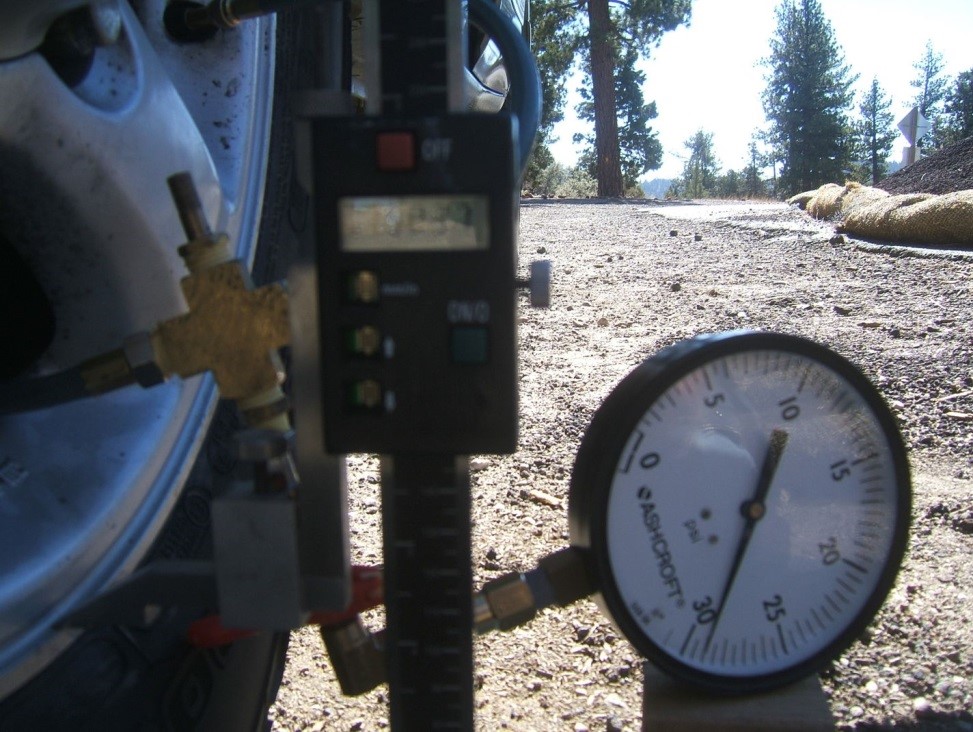 MEASURING TIRE SIZE (3): To make sure that barometric pressure (change) on a steel belted vehicle tire didn’t enter into the test, I conducted the same tests at Onyx Summit (8,443’) in the nearby San Bernardino Mountains. The results were identical.
MEASURING TIRE SIZE (3): To make sure that barometric pressure (change) on a steel belted vehicle tire didn’t enter into the test, I conducted the same tests at Onyx Summit (8,443’) in the nearby San Bernardino Mountains. The results were identical.
CONCLUSION (1): At street pressure, tires do not change size. At offroad pressures, tires only slightly changes pressure (size) with weight. Elevation change was inconsequential to the test.
CONCLUSION (2): Once a tire is inflated to street pressure, it does not change size or pressure with weight or elevation. Think of your inflated tire as more or less being a submarine hull. However, I was surprised to learn that this analogy has qualifications. Nuclear subs actually shrink with pressure and expand at the surface! The test tires only saw a 3.96 PSI change. The newest subs see a 14.7 to 1,500 PSIA increase in pressure!
TRIVIA: Have you ever heard that it’s not your tires that support your 4X? It’s the air inside the tire that does this hefty job. Remember me saying PSI is PSI weighted tire or not? Using a conventional bicycle pump, here’s what’s going on. As you push the handle down, the area of the plunger encounters the air pressure resistance of the plunger’s output side, the hose side (tire). If nothing is attached, then there is no air pressure resistance to the handle. Connect it to a 10 PSI bicycle tire and you are encountering 10 PSI times the area of the plunger. For simplicity, let’s say the plunger is one square inch, so the resistance will be 10 pounds. Connect it to any size tire, bigger or smaller, at 10 PSI and you will encounter the same resistance, 10 pounds. Let’s say that you are airing up your 4X’s 10 PSI tires for the trip home. What resistance do you encounter at the handle? You encounter the same 10 pounds as with any tire weighted or not. On the next stroke, you are lifting the 4X; but you are only encountering the tire’s 10 PSI resistance of the plunger. As the pressure goes up, so does the resistance but that has nothing to do with your tires being on or off the ground. It’s the same, tire on or off the ground.
DOES TIRE PRESSURE CHANGE WITH TEMPERATURE? Everybody knows the answer to this is yes, but does the change depend on the gas inside and are there any funny things going on and how much does it change and ??? Hang on to your tire gauges. We’ll take these on one at a time.
 DOES TEMP, TIRE PRESSURE CHANGE WITH DIFFERENT GASES? This is the subject of the link below. Basically I proved well beyond any doubt that the gas, be it air, CO2, nitrogen, helium or whatever, does not change the temperature effects. My tests agree with the 360 year old information that Robert Boyle proved in 1660 (the Ideal Gas Law guy). All gasses act the same with temperature change. And I can now hear the nitrogen buffs clamoring and wailing, “Foul! Foul! Foul!” This download proves that Boyle and I are right. The nitrogen marketing hype guys are full of hot air.
DOES TEMP, TIRE PRESSURE CHANGE WITH DIFFERENT GASES? This is the subject of the link below. Basically I proved well beyond any doubt that the gas, be it air, CO2, nitrogen, helium or whatever, does not change the temperature effects. My tests agree with the 360 year old information that Robert Boyle proved in 1660 (the Ideal Gas Law guy). All gasses act the same with temperature change. And I can now hear the nitrogen buffs clamoring and wailing, “Foul! Foul! Foul!” This download proves that Boyle and I are right. The nitrogen marketing hype guys are full of hot air.
TEMPERATURE FUNNY BUSINESS 1: Fresh back from a Baja trip (see NOSTALGIA far below), I began to studied temperature-related tire pressure changes. I learned that my data did not follow Boyle’s Law. After a month of perplexing frustration, I figured out why. The compressed air we fill our tires with is wet! Your compressor compresses humid air. Water vapor or droplets expand at about 800 times the rate of any dry gas. Steam engines are based on this principle. Also, NASCAR teams know that the moisture content of the inflation gas has to be considered. That’s why they use (dry) nitrogen to inflate their tires in lieu of wet, compressed air. This is the basis for the nitrogen hype, “Why do you think NASCAR uses it?” But the teams use nitrogen only because it’s dry, not because it doesn’t expand with temperature. And you might also be interested to know that dry, compressed nitrogen is way cheaper than dry, compressed air. The NASCAR guys are using the economical, techie solution, not the nitrogen, hype-related solution.
TEMPERATURE FUNNY BUSINESS 2: Temperature affects everything, so what does it do to a tire gauge? We gotta consider that, too. To make it easy, temperature does not affect gauges with these two considerations.
One, considering analog gauges must be lubricated, if they get cold enough to thicken- the grease, the watch-like mechanical movements within may be compromised. Technically, grease and oils do not freeze; they just get thicker and thicker and thicker with cold (Grease (Lubricant) from Wikipedia.org ).
Two, digital gauges could also be affected by temperature. However, they can be designed with built-in temperature compensation circuitry. I’ve never asked about or tested for this. My gauges, regardless of type, always come from my console to my cozy, warm pocket and out into any environment, cold or hot, for a quick pressure check. If you have an open 4X, carry your gauges in your pocket for peace of mind.
TEMPERATURE FUNNY BUSINESS 3: This one kinda relates to the tire size change with pressure thing above. Does the tire size change with hot and cold? Basically, the answer is no, and here’s more on that. You’ll hafta take my word on this because it’s hard to heat the tire and not the air inside for a test!
For tires, due to the combined strength of the rubber, sidewall cords and particularly the steel belts in the tread, the size change is miniscule for temperature change…I hypothesize. Once inflated, tires more or less stay the same size. This is key to understanding tire pressure change with temperature. My conclusion: Heat any tire filled with any gas and the pressure will increase. Cool the tire (gas, too) and the pressure will decrease, but in neither case does the tire size change. Now let’s take a closer look at how gas or air in the tire changes pressure with temperature.
GAUGE FUNNY BUSINESS: Boyle throws a couple of wrenches into the works with pressure and temperature (treated below) change. He and Mother Nature require we use an absolute pressure scale, PSIA. PSIG is what our tire pressure gauges measure and that does not start a zero. PSIA starts with sea level pressure or 14.7 PSIG. All PSIA gauges start at zero, nada, zilch, like in deep space! Both PSIA and PSIG are addressed here Compensating Tire Pressure Readings for Elevation and How Tire Pressure Guages Work.
NASCAR teams use PSIA gauges for another reason and they are expensive. For gauges, they choose the techie-correct solution in contrast to nitrogen above. Mine cost over 150 bucks! A PSIA gauge is not affected by elevation or barometric pressure. At sea level, our gauges read 0.0 PSIG when attached to nothing. PSIA gauges read 14.7 (PSIA) when connected to nothing! But my PSIA gage can be adjusted for barometric pressure with the simple touch of a button that zeros it to the current barometric pressure. The teams can push the “magic button” at any elevation or barometric pressure. PSIA gauges compensate for barometric pressure, wherever, whenever.
 HOW DOES TIRE PRESSURE CHANGE WITH TEMPERATURE? The precise answer to this, Boyle’s Law, puts another kink in the works. All temperature scales are not created equal just as with pressure scales. Here’s a quick glance at various temperature scales to clear things up.
HOW DOES TIRE PRESSURE CHANGE WITH TEMPERATURE? The precise answer to this, Boyle’s Law, puts another kink in the works. All temperature scales are not created equal just as with pressure scales. Here’s a quick glance at various temperature scales to clear things up.
Most likely you all know about Fahrenheit and Celsius (modern name for centigrade). But, do you know about three others? These take the wrench out of using Boyle’s Law. The three scales are Kelvin, Rankine and Planck. They are absolute temperature scales. We will neglect the Planck scale used by the astronomical community and also the Celsius and Kelvin scales used by the metric guys. I’ll use the antiquated, absolute temperature scale of Rankine. It’s a Fahrenheit-equivalent and makes understanding absolute temperature scales easier.
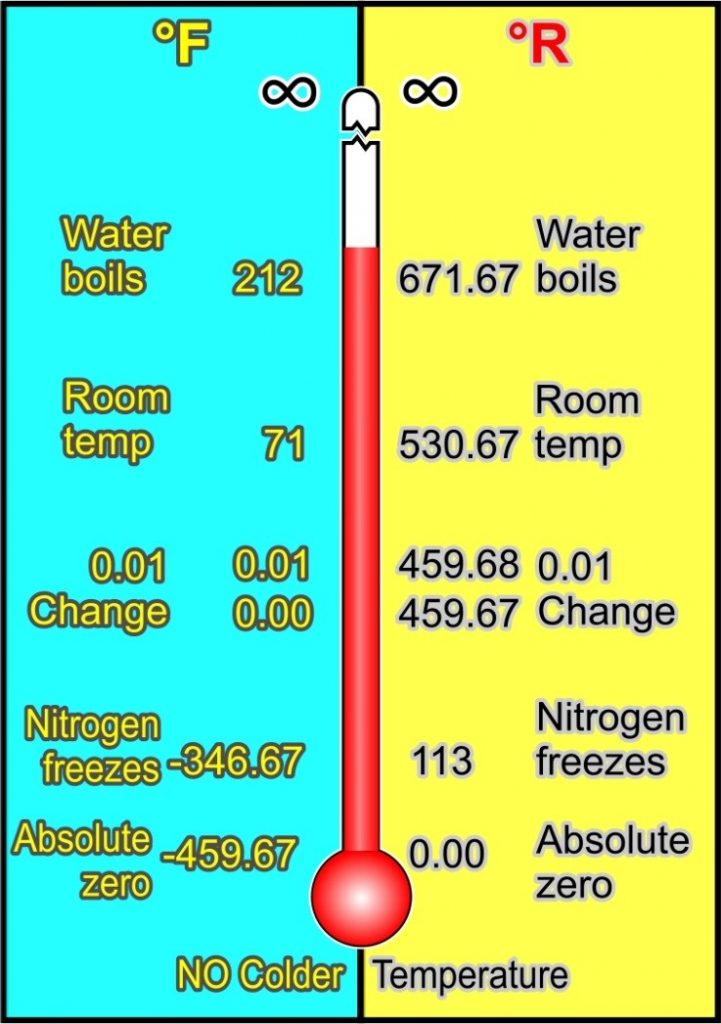 You obviously know that Fahrenheit thermometers have minus numbers, right? BTW, so does Celsius. I’ll use the temperature of liquid nitrogen to bring this minus thing into perspective. In Fahrenheit, nitrogen is a liquid at –346°F. At its absolute Rankine brother, it goes liquid at +113°R. Note that this is a positive number, but both are measuring the same thing, liquid nitrogen. Absolute scales, all of ’em, have no minus temperatures. Rankine, starts at absolute zero and uses Fahrenheit degrees to move up. That makes a one degree change in Rankine identical to a one Fahrenheit degree change. However, Mother Nature (Boyle’s Law) dictates that absolute scales must be used for calculating all sorts of things. This thermometer graphic may help understand the relationship between Fahrenheit and Rankine.
You obviously know that Fahrenheit thermometers have minus numbers, right? BTW, so does Celsius. I’ll use the temperature of liquid nitrogen to bring this minus thing into perspective. In Fahrenheit, nitrogen is a liquid at –346°F. At its absolute Rankine brother, it goes liquid at +113°R. Note that this is a positive number, but both are measuring the same thing, liquid nitrogen. Absolute scales, all of ’em, have no minus temperatures. Rankine, starts at absolute zero and uses Fahrenheit degrees to move up. That makes a one degree change in Rankine identical to a one Fahrenheit degree change. However, Mother Nature (Boyle’s Law) dictates that absolute scales must be used for calculating all sorts of things. This thermometer graphic may help understand the relationship between Fahrenheit and Rankine.
After bearing with me for over 3000 words and studying 11 pictures and icons (thank you), let’s shoot from the hip, skip Boyle’s Law and take a look at approximating temperature/pressure change.
APPROXIMATING TEMPERATURE/TIRE PRESSURE CHANGE: Starting at 7:00AM (50°F), you check and find your tires are at 10 PSI all the way around. At noon, it is 100°F and you find your tires are at 12.5 PSI. Hmm, since that’s a 100% temp increase, wouldn’t you think that a 100% increase in pressure would result? Good, logical thinking but it ain’t so. That’s because you used the Fahrenheit scale and not an absolute scale to calculate the percent change. Remember, Mother Nature and Boyle dictate that’s what you’ve gotta use, no exceptions!
So, let’s take a Rankine look at what’s going on. The morning’s 50°F temp is actually 510°R and noon’s 100°F is 560°R. Note that this is still a 50 F-degree change. But in Rankine it’s a little less than a one percent change compared to the Fahrenheit change of 100%. This shows that you can’t approximate the change by using Fahrenheit. You must calculate a change using an absolute scale, period. However, we’re going to cheat and use Fahrenheit to estimate change … lucky us!
 ESTIMATING TIRE, TEMPERATURE CHANGE: Finally! This chart gives you approximation numbers for various base tire pressures. 10 and 20 PSIG are for estimating offroad pressure changes. 30 PSIG is for ballparking passenger car tire change. 40 PSI is for the HD truck guys. But beware; this chart assumes that you have dry air in your tires which 99% of us do not. Humidity is difficult to accommodate. Anyone out there know how to calculate that?
ESTIMATING TIRE, TEMPERATURE CHANGE: Finally! This chart gives you approximation numbers for various base tire pressures. 10 and 20 PSIG are for estimating offroad pressure changes. 30 PSIG is for ballparking passenger car tire change. 40 PSI is for the HD truck guys. But beware; this chart assumes that you have dry air in your tires which 99% of us do not. Humidity is difficult to accommodate. Anyone out there know how to calculate that?
| TIRE PRESSURE (PSIG) | PSI CHANGE PER 10°F |
|---|---|
| 10 | 0.47 |
| 20 | 0.65 |
| 30 | 0.93 |
| 40 | 1.27 |
GAUGES: For what it’s worth, I’m totally happy with using a good pencil gauge and a point and shoot, IR thermometer for measuring tire temp. But do be aware that the IR instrument only measures the tire’s surface temperature and not the air within. Depending on how long you have been driving or in and out of the sun, the air inside could still be close to morning cold. If you’ve been driving for a long time, in various directions and the sunny side changed, then you can assume the ambient air and the air in the tires are the same.
SUNNY AND SHADY SIDE TIRES: I’m not too tire-pressure particular and here’s why. Black everything absorbs the sun’s energy and heats up more than reflective things do. Ever put your arm on a black hood? I’ll bet that you only did that once! Flat black tires absorb heat more than you might think. I have measured sunny versus shady side temp differences of 40°F. Using the 20 PSI temperature, tire pressure approximation number below means that there will be a 26 PSI pressure difference between the shady side tires versus sunny side tires!
What does this mean? Cut yourself a little slack when setting and correcting your tire pressure. Let performance and results tell you how you’re doing tire pressure-wise and not your tire pressure gauge.
 NOSTALGIA: The above Boyle’s Law frustration came after making a cold morning start out of Guadalupe Hot Springs (one of my tours), in North Baja, Mexico, high in what I call the Laguna Hanson Mountains to the east of Parque Nacional Constitución de 1857. We had 40 miles of straight, due north dirt road to the boarder ahead of us. After 20 miles, with the Baja sun beating down on our right side tires, we took a break. I measured both sides of 10 plus 4Xs. The temp difference was about 40°F and the pressure difference was 15 PSI, average. That did not fit with Boyle’s Law.
NOSTALGIA: The above Boyle’s Law frustration came after making a cold morning start out of Guadalupe Hot Springs (one of my tours), in North Baja, Mexico, high in what I call the Laguna Hanson Mountains to the east of Parque Nacional Constitución de 1857. We had 40 miles of straight, due north dirt road to the boarder ahead of us. After 20 miles, with the Baja sun beating down on our right side tires, we took a break. I measured both sides of 10 plus 4Xs. The temp difference was about 40°F and the pressure difference was 15 PSI, average. That did not fit with Boyle’s Law.
 FINAL CONCLUSION: Temperature tire pressure change must not be neglected, but treating it like your first born is overkill.
FINAL CONCLUSION: Temperature tire pressure change must not be neglected, but treating it like your first born is overkill.

